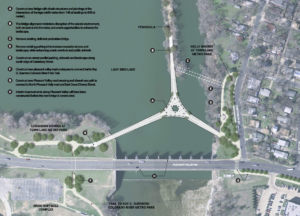Construction imminent for Longhorn Dam bridge
Monday, March 1, 2021 by
Harrison Young The Austin Transportation Department has decided on Longhorn Dam’s new bike and pedestrian bridge, which is designed to increase safety on Pleasant Valley Road and connect trails and parks in the area.

The bridge’s design is “wishbone style” and will be located near Guerrero Park on Pleasant Valley Road. After removing the current pedestrian bridge, new walkways will connect Holly Shores Park, Longhorn Shores Park and the Ann and Roy Butler Hike-and-Bike Trail. The bridge is expected to be completed in 2025.
Before the actual bridge can be built, ATD plans to install “interim improvements” on Pleasant Valley which include features like pedestrian hybrid beacons at crosswalks and significantly widen pathways on either side of the street to bolster walkers’ safety. Construction was scheduled to begin in January, but the winter storm caused significant delays.
“We are working quickly to get that work started, but it’s been a couple of weeks later than we thought,” ATD spokesperson Emily Tuttle explained.
Since the crews that were slated to work on the beacons are working on emergency response efforts and installation requires dry soil, more days were added to the timeline.
Some work has been done on the project, such as identifying power sources for the beacons, but more robust construction will begin in March. The wishbone bridge will be built after these features are added
The design decision comes after years of discussion starting in 2016. After funding was approved, a consultant was selected in 2018 to carry out preliminary engineering and public input began in 2019. The projected cost is $12.6 million.
The center of the bridge will feature a trellis structure with vine cover as well as benches and LED lights for safety. The current parking lot on Canterbury Street will be replaced with parallel parking spaces to make way for a walkway to the bridge. Underneath, a new tunnel will be constructed and the old one filled in.
The Transportation Department says it will honor existing landmarks, like the scenic overlook memorializing Tejano music legend Roy Montelongo and installations by artist Connie Arismendi. ATD will also identify organizations to partner with to maintain the bridge as well as coordinate live music, outdoor education and other events.
The design was chosen after a 2019 public survey in which 41 percent of respondents favored the wishbone design out of five options. The next most popular design garnered only 19 percent. Categories taken into consideration were safety, accessibility, environmental impact and cost.
ATD is adding safety features like reduced speed limits, more crosswalks, wider shared-use paths, and connections to other trails to increase pedestrian access around the Pleasant Valley area before construction begins on the bridge. One of the main drivers behind the project is mitigating road injuries and fatalities on Pleasant Valley, one of Austin’s most dangerous streets and a Vision Zero High-Injury Roadway.
A physical barrier will be constructed between lanes to reduce head-to-head collisions. New left-turn lanes will also be added to the roadway.
The Vision Zero team uses a Comprehensive Crash Cost tool to determine the impact of traffic crashes. This number takes into account things like medical expenses, property damage and wage loss to more vividly illustrate the toll that car wrecks take on the community.
Project funding comes from the 2016 mobility bond and Proposition B, which voters approved in November. Prop B allows for $102 million to be used on capital improvement projects, which the Longhorn Dam bridge qualifies for.
The other designs ATD explored were an upstream bridge, a downstream bridge and widening the existing Pleasant Valley bridge.
Renderings courtesy of the city of Austin. This story has been changed after publication to clarify the timeline and that the work currently underway is preparation the bridge construction.
The Austin Monitor’s work is made possible by donations from the community. Though our reporting covers donors from time to time, we are careful to keep business and editorial efforts separate while maintaining transparency. A complete list of donors is available here, and our code of ethics is explained here.
You're a community leader
And we’re honored you look to us for serious, in-depth news. You know a strong community needs local and dedicated watchdog reporting. We’re here for you and that won’t change. Now will you take the powerful next step and support our nonprofit news organization?












